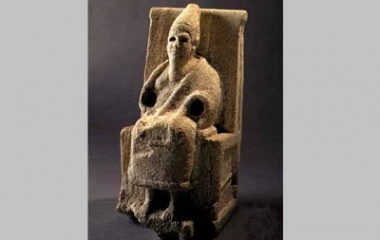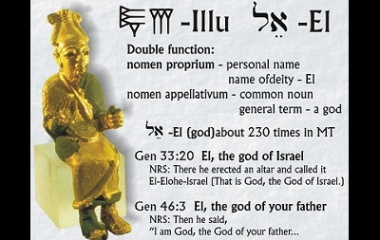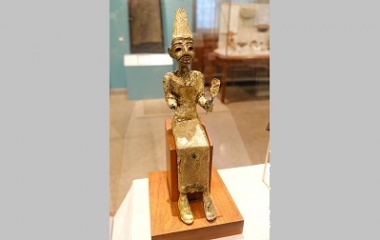- Pronunciation: EL
- Origin: Canaanite
- Role: God
- Symbols: Bull’s Horns
- Other Names: Elohim, Yahweh
- Wife: Asherah
- Children: Over 70
Who Is El?
El was known as the supreme god of the Canaanites in the mythology of the ancient Near East. He was the father of gods and men and the creator deity. He is sometimes depicted as a bull and known for his tremendous power and strength.
Origins
El was an important god in Canaanite mythology. It is believed that he lived on Mount Saphon, close to the ancient Syrian city of Ugarit. He was very respected and was considered by the people to be all-knowing and all-powerful. He was incredibly wise and compassionate to those that came to him for guidance, but not always.
Legends and Stories
There are not many myths that focus specifically on El. Instead, he finds a small roll in myths focused on other figures. To make it even more difficult to learn about him, many of the original tablets that spoke about him were discovered in poor shape, making several parts of myths involving El difficult to interpret.
Aqhat’s Myth
A story sourced from the city of Ugarit tells of Aqhat, the son of King Daniel. The king had been providing Kothar, the craftsman god, with a room in his palace. To show his gratitude for the gracious hospitality, Kothar gave Aqhat his personal bow and arrows. But the goddess Anat was upset and wanted the bow for herself. She tried to buy it from Aqhat with gold and silver but the prince refused her offer. She tried again to purchase the bow from him, offering him immortality this time. The prince was offended by the offer and told the goddess that he was a man destined to die and should not be cursed with immortality.
Anat was upset and went to El. She asked that the prince be killed. El gave her permission but upon Aqhat’s death, the land suffered a great drought and crops would no longer grow. Anat was upset and wanted to bring the prince back to life so that the people would no longer starve. As previously mentioned, the tablets containing Canaanite myths were poorly preserved, and the ending to this myth is unknown.
Baal’s Myth
Baal was the son of El, according to many accounts, but there are also sources that say he might have been more of a distant relative. Baal complained to El that he didn’t have a magnificent house like so many of the other gods did. He felt that he deserved such a house as he had just conquered Yam. El agreed and had a house built for Baal.
When the house was completed, Baal held a celebration. However, he did not invite his twin brother Mot. This angered Mot, who decided to invite him to the underworld, as he was the god of death. Though Baal was concerned, he didn’t want to risk insulting his brother again and took him up on his invitation. When Baal visited Mot, he saw that the table was set for a large feast. The food served was the food of death and when Baal ate it, he found himself trapped in the underworld.
While Baal was trapped, El began to search for someone to replace him. El’s wife suggested her son Ashtar. Ashtar was the god of irrigation but quickly realized that he could not fill Baal’s place, for when he sat on his throne he could not even reach the ground with his feet. El continued to look for a successor but once Baal’s wife fought Mot and was able to bring Baal back, the two continued to rule together.
Family
El was a supreme god. He was married and some sources say that he had over 70 children. Here are some of the more notable members of his family.
Asherah
Asherah was El’s wife and a Canaanite mother-goddess. She was also a sea-goddess and in some accounts is referred to as “Lady of the Sea”. She goes under many other names, including Lady of Byblos, Mother of the Gods, Queen of the Sea and Hathor.
Baal
Baal is said to be the god under El. Together, they ruled in tandem with Baal being the fertility god and god of storms. He was married to his sister Anat and possible had several other wives, including Arisya, Baalat, Padriya and Talliya. He fought a battle for control of the earth with Yam and killed Lotan, the serpent. It is said that he lived in Sapan, a large dwelling above the Earth which had a large hole in the floor so that he could water the ground below. His twin brother was Mot and when Baal died, his wife Anat fought and killed Mot, who was the god of the underworld. Baal was then brought back to life and regained his command. He is usually depicted as a strong warrior with a horned helmet.
Keret
Keret fought and defeated Etrah, the moon-god, who tried to take the kingdom from him. His wife was Hurriya, who passed before bearing him any children. Because he was childless, Keret went to a neighboring kingdom and stole the king’s daughter. He had seven sons with his new wife. One of them, Yasib, would fight Keret for his throne. Keret won the battle, even though he was ill. He was eventually cured by El.
Mot
Mot was the god of death. When he killed by Anat, his body was cut up and ground under her millstone.
Other children of El and Asherah include Adad, Anobret and Atak.
Appearance
In artistic representations, El is normally pictured as an older man with a very long beard. Because he was commonly referred to as “The Bull”, many pictures show him sitting down and wearing a crown with bull’s horns attached to it.
Symbology
Because El was often referred to as “The Bull” he is associated with the animal and more specifically, the horns of the animal. He was also immortal, with the ability to live forever.










